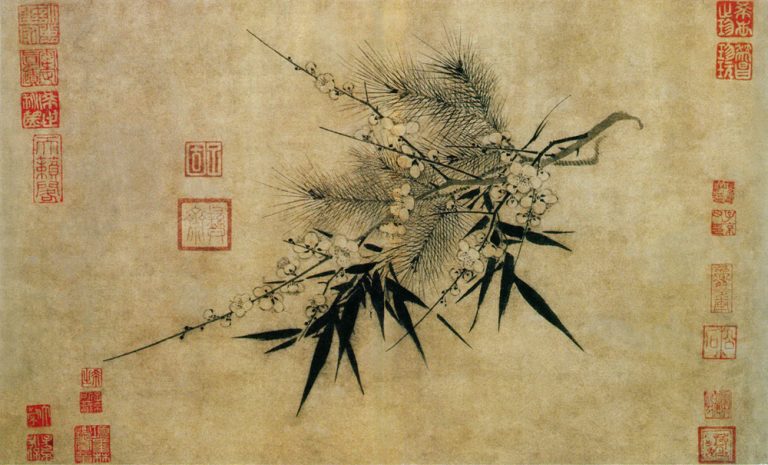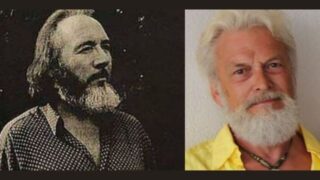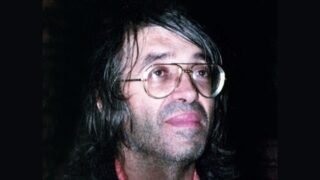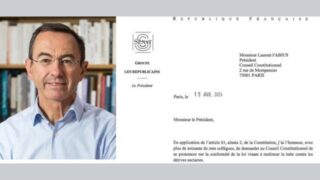French media have published dozens of articles on Cyrille Adam (Loup Blanc) after he was accused of sexual abuse and arrested in 2021. Who is he?
by Massimo Introvigne
Article 1 of 4.


The neoclassical Castle of Granès, located in a village in the French department of Tarn-et-Garonne, dates back to the 17th century, but was entirely rebuilt in 1886 following a project by renowned architect Jacques-Paul Lequeux (1846–1907). His majestic century-old peace was disturbed in the morning of December 7, 2021. Six carloads of police officers came to raid the castle and arrested Cyrille Adam, a spiritual master known to his students as “Loup Blanc” (White Wolf), who taught and gave initiations to students there.
After a disgruntled ex-member had accused him of abuse of vulnerability (abus de faiblesse), regarded in France as the crime, typical of “cults,” that involves the use of psychological techniques to control “cult victims,” and five women claimed they had been abused, Loup Blanc was arrested. The French specialized anti-cult police CAIMADES (Assistance and Intervention Unit in the Field of Cultic Deviances, Cellule d’assistance et d’intervention en matière de dérives sectaires), started looking for other “victims” prepared to testify, including by posting an appeal on Twitter, which was picked up and publicized by twenty-one different French media.
The saga of Loup Blanc started, with dozens of articles about the “sex shaman” published in France (69 until January 2023, plus five video reports broadcasted by TV networks or social media). French media have a strong bias about groups labeled as “cults” (sectes), and this story featuring sex, shamanism, and mysterious rituals promised to be particularly juicy.


I have studied several groups teaching sacred eroticism whose leaders were accused of sexual abuse, from the Romanian movement MISA to the Czech Guru Jára Path, and beyond. I have emphasized in my studies of these groups, and reiterate here once again, that I do not condone sexual abuse, and do not believe that its perpetrators can protect themselves by invoking freedom of religion or belief.
Studying movements whose practices include sacred eroticism, on which I started publishing in 1990 through a book that remains an oft-quoted reference in the field, “Il cappello del mago” (The Magician’s Hat), is a delicate matter. By exploring these movements for more than thirty years, I did come across instances of abuse. Even more often, I encountered cases in which anti-cultists, the media, and the police argued that practices combining spirituality and eroticism in which women are led by a male guru through sex-based rituals are always and by definition abusive. If the women themselves deny the abuse, it is because they are victims of brainwashing. Not believing in the existence of brainwashing, I do not accept this theory either, and maintain that each case should be studied in its own context.
It is not for scholars to assess whether Loup Blanc is guilty or innocent. We are simply not equipped to ascertain what really happened between him and those who are now the plaintiffs in the criminal case. However, scholars specialized in new religious movements can contribute to the debate on Loup Blanc a piece missing in the media discussion: a reconstruction of what his teachings are all about, and why a certain number of students follow him.
My sources are the voluminous public and internal literature of Loup Blanc’s group of students, written statements by several of his students, and personal interviews with ten students (eight women and two men, for whom I use pseudonyms) in February and March 2023. I also interviewed the lawyer representing Loup Blanc, read the statements of those plaintiffs in the court case who talked to the media, and a good number of hostile articles. Finally, I submitted some question to Loup Blanc himself, who answered them from jail.


Loup Blanc is defined by the media as a “guru” or “shaman,” but he prefers to be called a “passeur d’âmes,” a “ferryman of souls.” “There are all kinds of jobs on this globe, he writes, but the most beautiful and the most useful is that of a ferryman, not just any ferryman, but the ferryman of souls. Yes, a ferryman of souls! The ferryman would take people across to the other side when there was no bridge, that’s what KYRIOS [one of the first names he used, before ‘Loup Blanc’] does in the simplest way possible. No decoration on the boat, no fuss, no muss, whether it’s decorated or simple it will take you to the other side. The other shore KYRIOS is talking about is the one we don’t even know exists. Perhaps we have heard of it, but we have never wanted to make the effort to set foot on it. KYRIOS helps us because it knows this other shore, the inner shore, and this is what he proposes to us: to go to the other, inner shore and set foot on this still virgin land that conceals unsuspected treasures.”
A “passeur d’âmes” is born rather than made. Born in Chantilly, in Paris’ metropolitan area, on December 20, 1951, Loup Blanc reports that he had his first spiritual experiences at age 7. Answering my questions about his first experiences, he added that “When he was about 18 years old, the Christ appeared in the room where he was relaxing, he was full of light, alive, real. The Christ took out his sacred heart and put it in his [Loup Blanc’s] heart and said, ‘I give you my sacred heart to fight scorpions and snakes.’”
After having practiced martial arts for several years, and achieved a certain fame as a self-taught poet, painter, musician, and photographer, Cyrille Adam, in his own words, realized in 1980 that “believing he was doing many things, he understood that in fact he was not doing anything at all.” In that year, “something came down from heaven to encounter this being [Loup Blanc]” and his “life changed completely.” On February 2, 1982, he gave his first public lecture.


In 1983, the first structure gathering his students and coordinating his work was created, with the name Invitation à la Vie (no relations with the new religious movement founded with the same name, coincidentally in the same year 1983, by Yvonne Trubert). As the main structure for Loup Blanc’s students, it was replaced by Association Nitya Yoga in 1988, Association Harmonia in 1989, and Association Oxyon 777 in 1994. The latter was dissolved in 1999, in a context marked by the French controversies about “cults,” to which I will return. A number of auxiliary organizations were also established: publishing houses, real estate managing companies, and an Académie européenne du Qi Gong Chinois de l’envol de la grue et techniques affinitaires (European Academy of Crane Flight Qi Gong and Similar Techniques), founded in 1996 and managing inter alia Qi Gong stages in France with masters invited from China.
Originally, Loup Blanc lectured and conducted the group stages called “initiations” in rented locations and in the premises of some students, including a farm in Brou (near Chartres) and lodges in Soeuvres (near Vézelay). In 2001, a student bought the Castle of Granès, where most initiations have taken place since, including after December 2020 when the castle was sold to an American gentleman who continues to rent it to the association managing the activities of Loup Blanc. Two students bought in 1999 a house in Sumène (Gard), where Loup Blanc, who lived beforehand in rented apartments or in the homes of followers, resided until July 2021. He then moved to a property bought by students un the Western Pyrenees, which also serves as a spiritual, ecological, and artistic center.


Stages were also offered in Peru, where land was bought in 2006 in El Paraíso (The Heaven), and some wooden houses were built. Three students moved there. There was no electricity, and the houses were very simple. However, my interviewees who went there found the experience “beautiful” and even “magnificent.” Stages lasted normally for three weeks, with students preparing during the day and experiencing with ayahuasca at night. They underline that they always respected the law, and never took ayahuasca in Europe, where laws may regard it as prohibited, except once in Spain, at a time when local laws did not forbid its use. My interviewees described the experience as very powerful. Danièle called it “the experience of a lifetime,” and noted she would not have done it with just any other shaman offering ayahuasca in Peru. She overcame her reservations only because she trusted Loup Blanc.
In 2012, the work in Peru was discontinued and the property was put on sale. Quarrels followed with a Peruvian who had served as the local manager of the center. His niece had married one of Loup Blanc’s students, S., who had once been the closest advisor of the master and whom some even regarded as his possible successor. However, he left the group, decided to remain in Peru with his wife, and started giving independent courses of shamanism. The economic and property quarrels with the former local manager are now before the Peruvian courts.
From 1990, Loup Blanc had traveled to meet spiritual masters from several different traditions. He regards as important his visit in 1996 to the ashram of Swami Muktananda (1908–1982) in Ganeshpuri, India, where he received a Tantric initiation (Shaktipat) and experienced the awakening of the Kundalini.
Gradually, a model developed where he would visit renowned teachers from different traditions in their spiritual centers and then invite them to France to lecture and conduct stages for his students. Some of my interviewees jokingly observed that this behavior seems to be the contrary of what should be typical of “cult” leaders, who prevent their students from meeting other spiritual masters who may eventually become their competitors. On the contrary, the model including a visit by Loup Blanc and an invitation to France was followed in the case of Swami Chetan of Haridwar (1990); the Rinzai Zen Buddhist roshi Eido Tai Shimano (1932–2018; 1992)—who many years later was also accused of sexual abuses during Zen private sessions with female students, although the case never proceeded to court—; Chinese Crane Flight Qi Gong master Zhao Jin Xiang (1993–1998); Taoist and traditional Chinese medicine master Wan Su Jian (1993–2014); Venerable Jamyang Tashi Dorje, the abbot of the Sakya Tashi Ling Monastery in Olivella, Spain (2000–2001); Shoshone Native American ritual specialist Clyde Hall (1999–2000). The cooperation with Clyde Hall, who is one of the most well-known leaders of the gay Native American movement, runs counter accusations of homophobia recently raised against Loup Blanc in some French media.
Loup Blanc also met leaders of the Indian movement Brahma Kumaris, visited with his students the German ashram of Mother Meera, an independent student of Sri Aurobindo (1872–1950), and cooperated with several Peruvian shamans. He continued his international contacts well into the 21st century. In 2016 and 2017, for example, after a trip to Mongolia, a local shaman called Grandmother Ayangat visited Loup Blanc and his students in France . The group’s website includes words of appreciations for Loup Blanc by traditional healers and spiritual masters of different cultures. His students have kept documents and pictures of all these encounters with international spiritual leaders. The different names used by Loup Blanc reflect the different traditions he draws from: Kyrios, Ahimsa Hridayananda, Wan-Yang, J.L.B. (Joachim Loup Blanc).


An outside observer may recognize in Loup Blanc’s books elements coming from Western Esotericism as well, including the Theosophical tradition, although explicit references to esoteric masters are scarce and, in his answers to my questions, he stated that “he knows about Theosophy, yes, but he has never read a book on the subject nor has he [been] enrolled in their lodges.” George Ivanovich Gurdjieff (1866?–1949) is mentioned in passing as having been himself “a Tantric Master.” Esoteric Christianity is also a key reference, as evidenced by the first books published by Loup Blanc in 1988, “Mudra-Pater,” an esoteric interpretation of the Lord’s Prayer and a guide to translate it into movements of the body (republished in 2001 with prefaces by former Dominican turned Orthodox priest Jean-Yves Leloup and Venerable Jamyang Tashi Dorje), and “Les Chants du Vivant” (Songs of the Living) of 1992, a collection of poems.
Loup Blanc, however, distinguishes between the genuine teachings of the Avatar Jesus and what he regards as their distortion by organized religion, particularly the Catholic Church. The theme returns in many of his writings: “it is not a reference, this Roman Catholic Church! Many crimes have been committed in the name of its son of God; it wanted to impose its beliefs through violence and fear! Jesus, who was only love and tolerance, would never have wanted this in his lifetime.”
Like other contemporary esoteric teachers, Loup Blanc also accuses the Christian churches of having replaced the doctrine of reincarnation, which was “clearly explained in the Gospel,” with the “absurdity” of the resurrection of the flesh.


While it is part of the scholars’ work to investigate the possible sources of spiritual teachings, Loup Blanc insists that he discovered most of what he teaches by himself. In 2002, he published the first volume of “Le Voyageur incorporel” (The Incorporeal Traveler), to be followed in the future by two further installments. It is a long chronicle of dreams where he encounters a being he nicknames “the Blue Sage” and who tells him he can call him “Jean.” This “master” may be Loup Blanc’s higher self, or the Supreme Consciousness of the universe. When asked who gives him the order to divulge or not to divulge a certain teaching, he answered that “he could say the Supreme Consciousness or a Spiritual Assembly or a Cosmic Avatar… What good would it do if He told you where these Orders come from? Anyway, you would not be able to understand and even believe it!”









